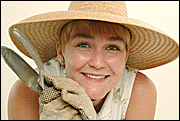Advertisement - Click to support our sponsors.


Dig This![]()
Friday, November 3, 2000

By Craig T. Kojima, Star-Bulletin
Kim Anderson and Kimberly Clark tend a
Millennium Garden, designed as a long-term
organic food source.
Self-reliance has a long history in the United States. Its best-known champion, the 19th-century writer Ralph Waldo Emerson, called self-reliance the height and perfection of man. Old values for
a new millenniumA hundred years later, hippies took their dog-eared copies of Emerson's essays out into the woods and formed communes.
The ideas of small-scale living, cooperation and sustainability may not be new, but organic farmer Kimberly Clark sees them as perfectly suited for the millennium.
Clark, who has long taught gardening classes, was asked last year to come up with a class that addressed Y2K fears.
"It was like, right before you're ready to starve you should put some seeds in the ground. I thought that was too depressing," she said. But she did design a class, and named it "How to Grow a Millennium Garden."
"It's getting back to basics," she said. "It's teaching people how to successfully grow organic produce so they can actually feed themselves over time.
"It's just trying to live in balance with nature."
"How to Grow a Millennium Garden" covers organic gardening, plant nutrition, permiculture, soil preparation and maintenance. Clark teaches it in partnership with Jon Biloon, a Big Island organic farmer, soil researcher and environmental activist.
Most people know organic farming means no chemicals are used. That means plant nutrition, as well as pest and disease control are dealt with by natural means. Much of this revolves around soil health.
Tropical soils, like those in Hawaii, are notorious for mineral depletion. High levels of rainfall are partly responsible, large-scale agriculture greatly compounds the problem, said Biloon.
"Basically, what I focus on is remineralization," he said. "The minerals we focus on are calcium magnesium and potassium, we get those in balance and everything else falls into place. A healthy soil yields healthy crops."
Hawaii's uninterrupted growing season and the boon that yields to bugs and disease makes a healthy soil and its accompanying microbes even more important.
In addition to the introduction of minerals through crushed rock and other means, Biloon will talk about the use of cover crops, compost and mineral fixing trees as soil strengthening strategies.
Both Clark, who runs the Just Add Water farm in Waimanalo, and Biloon have experience growing a wide variety of crops.
Biloon's 11-acre farm yields awa, coffee, vegetables, avocados, bananas and papayas, of which he is particularly proud as they are not genetically engineered and are virus-free.
"We don't have to grow things with chemicals," said Biloon, who has compiled a litany of charges of health and environmental damage done by traditional agribusiness.
Clark's segments of the class delve into the organization of a Millennium Garden.
"We teach you how to sequence things," she said.
"Root crops are the things you plant first, because they take the longest to mature."
Greens, which mature fastest, are planted last.
"You garden by the phases of the moon," said Clark.
The new moon is good for planting seeds for above-ground crops.
"At the full moon, you plant root crops and anything you want to transplant, like seedlings.
"When the moon is going from small to large it pulls above ground, when it is going from large to small it pulls below ground," she said.
While this all may sound very "New Age," almanacs and moon cycles have long been used by farmers, said Clark.
She also discusses the permiculture method of sustainable agriculture.
"It's basically a landscape approach to ecology," she said. "We teach that in the class to help people understand some principles of gardening and to help them lay out their garden beds. ... To help them manage the property more efficiently," said Clark.
Crop diversity is one focus of permiculture and Clark looks at dietary needs when talking about which crops to plant.
"We look at why people are sick right now because of heavy metals and transfatty acids in our food," she said.
In the class, she details the minerals offered by different plants.
"That way you can formulate what kind of garden you really want," said Clark.
Her nutritional focus is on maintaining basic health and dealing with daily anxiety.
"You require more minerals in order to stay grounded. Calcium and magnesium are the things you need when you have more stress in your life. You get them through leafy green vegetables," said Clark.
Biloon's dim view of large-scale commercial agriculture makes the home garden something of a nutritional imperative for him.
"The only way we're going to be healthy is to grow our own food," he said.
How to Grow
a Millennium GardenWhen: Nov. 4 class covers introduction, nutrition and permiculture; Nov. 11 class covers soil and maintenance; both 10 a.m. to noon.
Where: 41-851C Waikupanaha St., Waimanalo
Cost: $35 per class or $65 for both
Call: 259-5635
Gardening Calendar in Do It Electric!
Stephanie Kendrick's gardening column runs Fridays in Today.
You can write her at the Star-Bulletin, P.O. Box 3080, Honolulu 96802
or email skendrick@starbulletin.com